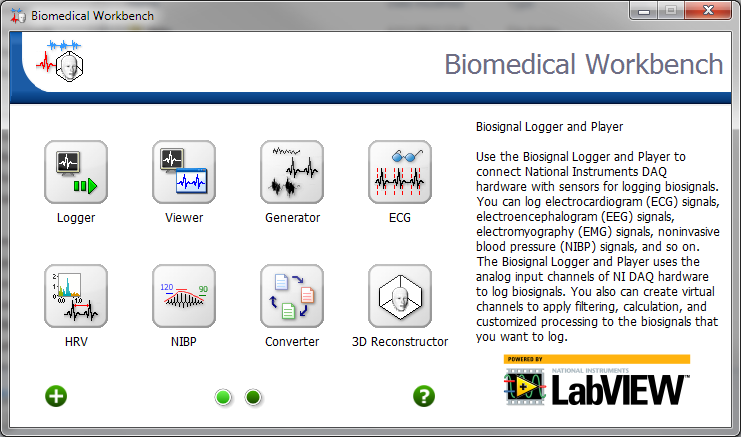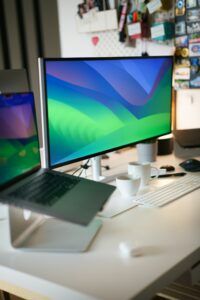Developing LabVIEW Applications for Biomedical Engineering

Introduction
Biomedical engineering is an interdisciplinary field that applies principles of engineering and biology to create solutions for healthcare and medical challenges. LabVIEW (Laboratory Virtual Instrument Engineering Workbench), a graphical programming environment developed by National Instruments (NI), is a versatile tool that offers powerful capabilities for developing applications in biomedical engineering. This comprehensive guide delves into the essential concepts, methodologies, and practical implementations of LabVIEW in the biomedical field. By the end of this article, you will have a thorough understanding of how to leverage LabVIEW’s capabilities to create innovative and effective biomedical engineering applications.
Overview of LabVIEW
LabVIEW is known for its graphical programming language (G), which simplifies the development process by allowing users to create programs using visual block diagrams. Key features of LabVIEW include:
- Graphical Programming: Simplifies coding through an intuitive, visual approach.
- Hardware Integration: Easily connects with a wide range of biomedical sensors and devices.
- Real-Time Data Acquisition: Facilitates real-time data collection and analysis.
- Extensive Libraries: Provides robust libraries for signal processing, control systems, and data visualization.
- Modularity and Scalability: Supports the development of scalable and modular applications.
Key Components of Biomedical Engineering Applications
1. Biomedical Signal Acquisition and Processing
Biomedical signal acquisition and processing are fundamental to many applications in biomedical engineering. LabVIEW offers extensive tools for acquiring, processing, and analyzing biomedical signals such as ECG, EEG, and EMG.
Example: Developing an ECG Monitoring System
- Hardware Setup:
- Use ECG sensors to capture cardiac signals.
- Connect the sensors to an NI DAQ device for signal acquisition.
- Signal Acquisition:
- Configure the DAQ system to acquire ECG signals in real-time.
- Use LabVIEW to visualize the acquired signals.
- Signal Processing:
- Apply filtering techniques to remove noise from the ECG signals.
- Implement algorithms to detect QRS complexes and calculate heart rate.
- Analysis and Visualization:
- Develop tools to analyze ECG waveforms and identify abnormalities.
- Use LabVIEW’s visualization capabilities to display ECG data in a user-friendly format.
2. Medical Imaging
Medical imaging is a critical area in biomedical engineering. LabVIEW can be used to develop applications for acquiring, processing, and analyzing medical images from modalities such as MRI, CT, and ultrasound.
Example: Developing an Ultrasound Imaging System
- Image Acquisition:
- Interface with ultrasound transducers to acquire image data.
- Use NI hardware to digitize and transfer the image data to a computer.
- Image Processing:
- Implement image processing algorithms to enhance image quality.
- Use LabVIEW’s Vision Development Module to apply filters and segmentation techniques.
- Image Analysis:
- Develop tools to measure anatomical structures and identify abnormalities.
- Use LabVIEW to visualize and analyze the processed images.
- Real-Time Display:
- Create a real-time display for ultrasound images.
- Ensure the system can handle the high data rates required for real-time imaging.
3. Biomechanics and Rehabilitation Engineering
Biomechanics and rehabilitation engineering focus on understanding the mechanics of the human body and developing devices to assist or rehabilitate patients. LabVIEW can be used to develop applications for motion analysis, prosthetics, and rehabilitation devices.
Example: Developing a Motion Analysis System for Gait Analysis
- Hardware Setup:
- Use motion capture cameras or inertial sensors to track body movements.
- Connect the sensors to an NI DAQ system for data acquisition.
- Data Acquisition:
- Configure the DAQ system to acquire motion data in real-time.
- Use LabVIEW to visualize and analyze the acquired data.
- Signal Processing:
- Implement algorithms to process motion data and extract kinematic parameters.
- Use filtering techniques to remove noise from the motion data.
- Analysis and Visualization:
- Develop tools to analyze gait patterns and identify abnormalities.
- Use LabVIEW’s visualization capabilities to create 3D animations of body movements.
- Rehabilitation Device Integration:
- Integrate the motion analysis system with rehabilitation devices such as exoskeletons.
- Use LabVIEW to control the devices based on the motion data.
4. Biomedical Instrumentation
Biomedical instrumentation involves the development of devices for measuring physiological parameters. LabVIEW’s capabilities for real-time data acquisition, processing, and control make it ideal for developing biomedical instruments.
Example: Developing a Blood Glucose Monitoring System
- Sensor Integration:
- Use glucose sensors to measure blood glucose levels.
- Connect the sensors to an NI DAQ device for data acquisition.
- Signal Processing:
- Implement algorithms to process the sensor data and calculate glucose levels.
- Use filtering techniques to remove noise from the sensor data.
- Data Analysis and Visualization:
- Develop tools to analyze blood glucose trends and identify abnormalities.
- Use LabVIEW’s visualization capabilities to display glucose data in a user-friendly format.
- User Interface:
- Create an interface for users to monitor their blood glucose levels.
- Include features for data logging and trend analysis.
- Alerts and Notifications:
- Implement alerts for abnormal glucose levels.
- Integrate with mobile devices for remote monitoring and notifications.
5. Telemedicine and Remote Monitoring
Telemedicine and remote monitoring are becoming increasingly important in healthcare. LabVIEW can be used to develop applications that enable remote monitoring of patients and facilitate telemedicine services.
Example: Developing a Remote Patient Monitoring System
- Sensor Integration:
- Use sensors to monitor vital signs such as heart rate, blood pressure, and oxygen levels.
- Connect the sensors to an NI DAQ device for data acquisition.
- Data Transmission:
- Implement communication protocols to transmit data to a remote server.
- Ensure secure and reliable data transmission.
- Remote Monitoring Interface:
- Develop a web-based or mobile interface for healthcare providers to monitor patients remotely.
- Use LabVIEW’s web services to create the interface.
- Data Analysis and Alerts:
- Implement algorithms to analyze the data and detect abnormalities.
- Create an alert system to notify healthcare providers of any issues.
- Patient Interaction:
- Develop tools for patients to communicate with healthcare providers.
- Include features for video conferencing and messaging.
Advanced Topics in Biomedical Engineering with LabVIEW
1. Machine Learning and AI Integration
Integrating machine learning (ML) and artificial intelligence (AI) into biomedical applications can enhance functionality and performance. LabVIEW supports integration with ML/AI tools such as Python and MATLAB.
Example: Developing an AI-Based Diagnostic System
- Data Collection:
- Acquire medical data such as patient records, imaging data, and sensor readings.
- Use LabVIEW to preprocess and clean the data.
- Model Training:
- Train machine learning models using Python or MATLAB.
- Develop models to diagnose diseases based on the medical data.
- Integration and Deployment:
- Integrate the trained models into LabVIEW for real-time diagnostics.
- Use LabVIEW to create a user interface for healthcare providers to interact with the diagnostic system.
- Performance Evaluation:
- Test the AI-based diagnostic system with real-world data.
- Validate the system’s accuracy and reliability.
2. Embedded Systems and FPGA Development
Embedded systems and FPGAs are essential for developing high-performance biomedical devices. LabVIEW provides specialized modules for programming and deploying applications on these platforms.
Example: Developing an FPGA-Based Biomedical Signal Processing System
- FPGA Design:
- Use LabVIEW FPGA Module to design signal processing algorithms.
- Implement real-time processing tasks such as filtering and feature extraction.
- Testing and Validation:
- Simulate the FPGA design to ensure correct functionality.
- Test the FPGA implementation using hardware-in-the-loop (HIL) testing.
- Deployment:
- Deploy the FPGA design on NI FPGA hardware.
- Integrate the FPGA with the rest of the biomedical system.
- Performance Optimization:
- Optimize the FPGA design for speed and efficiency.
- Ensure the system can handle high data rates required for real-time processing.
3. Cybersecurity in Biomedical Applications
Ensuring cybersecurity is critical in biomedical applications to protect sensitive patient data and ensure the integrity of medical devices. LabVIEW offers tools and best practices for securing applications.
Example: Developing a Secure Patient Data Management System
- Data Encryption:
- Implement encryption mechanisms to protect patient data.
- Use SSL/TLS protocols for secure data transmission.
- Access Control:
- Develop user authentication and authorization mechanisms.
- Use LabVIEW’s security libraries to manage credentials.
- Intrusion Detection and Prevention:
- Monitor network traffic for signs of intrusion.
- Implement real-time anomaly detection algorithms.
- Data Integrity:
- Ensure the integrity of patient data through checksums and hashing.
- Implement backup and recovery mechanisms.
- Compliance:
- Ensure the system complies with healthcare regulations such as HIPAA.
- Implement auditing and logging mechanisms to track data access and modifications.
Case Studies: Practical Applications of LabVIEW in Biomedical Engineering
Case Study 1: Developing a Portable ECG Device
Objective: Develop a portable ECG device for remote cardiac monitoring.
- System Requirements:
- Capture and transmit ECG signals.
- Provide real-time monitoring and analysis.
- Hardware Integration:
- Use portable ECG sensors to capture cardiac signals.
- Connect the sensors to a compact NI DAQ device.
- Signal Processing and Analysis:
- Implement real-time filtering and QRS detection algorithms.
- Use LabVIEW to analyze and visualize ECG data.
- Data Transmission:
- Implement wireless communication protocols to transmit data to a remote server.
- Ensure secure and reliable data transmission.
- User Interface:
- Develop a mobile application for patients to monitor their ECG data.
- Include features for data logging and trend analysis.
- Testing and Validation:
- Test the device with patients to validate its accuracy and reliability.
- Iterate on the design based on feedback and test results.
Case Study 2: Creating a Smart Prosthetic Limb
Objective: Develop a smart prosthetic limb with advanced control and feedback mechanisms.
- System Requirements:
- Provide intuitive control for the user.
- Offer real-time feedback on limb position and force.
- Sensor Integration:
- Use EMG sensors to capture muscle signals for limb control.
- Integrate force and position sensors for feedback.
- Control System Development:
- Implement control algorithms to translate EMG signals into limb movements.
- Use LabVIEW’s control design tools to optimize the control system.
- Real-Time Feedback:
- Develop feedback mechanisms to provide users with sensory information.
- Use LabVIEW to process and display feedback data.
- User Interface:
- Create an interface for users to calibrate and customize the prosthetic limb.
- Include features for monitoring performance and logging data.
- Testing and Iteration:
- Conduct usability tests with prosthetic limb users.
- Iterate on the design based on user feedback.
Case Study 3: Designing a Wearable Health Monitoring System
Objective: Develop a wearable device for continuous health monitoring.
- System Requirements:
- Monitor vital signs such as heart rate, temperature, and activity levels.
- Provide real-time data analysis and alerts.
- Sensor Integration:
- Use wearable sensors to capture health data.
- Connect the sensors to a compact NI DAQ device.
- Data Acquisition and Processing:
- Implement real-time data acquisition and processing algorithms.
- Use LabVIEW to analyze and visualize health data.
- Data Transmission:
- Implement wireless communication protocols to transmit data to a smartphone or cloud server.
- Ensure secure and reliable data transmission.
- User Interface:
- Develop a mobile application for users to monitor their health data.
- Include features for data logging, trend analysis, and alerts.
- Testing and Validation:
- Test the wearable device with users to validate its accuracy and usability.
- Iterate on the design based on feedback and test results.
Conclusion
LabVIEW is a powerful and versatile tool for developing applications in biomedical engineering. Its graphical programming environment, extensive libraries, and seamless hardware integration make it an ideal choice for creating innovative and effective biomedical solutions. By leveraging LabVIEW’s capabilities, engineers and researchers can accelerate the development process, reduce costs, and improve the quality and functionality of their biomedical applications.
Whether you are working on biomedical signal acquisition, medical imaging, biomechanics, biomedical instrumentation, or telemedicine, LabVIEW provides the tools and flexibility needed to bring your ideas to life. By following the methodologies and best practices outlined in this article, you can effectively use LabVIEW to develop applications that address the complex challenges of biomedical engineering and contribute to the advancement of healthcare and medicine.




